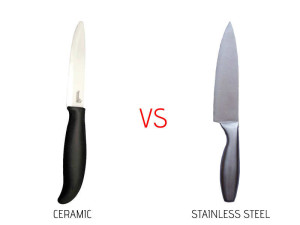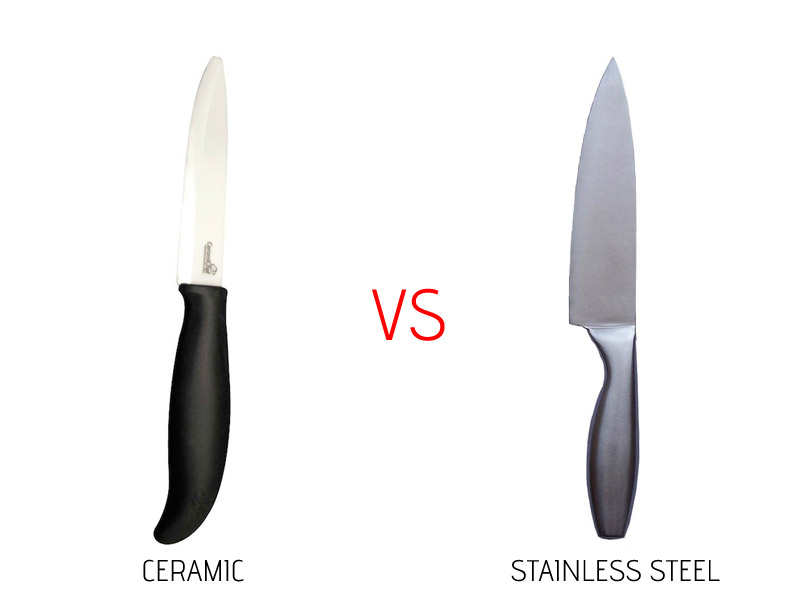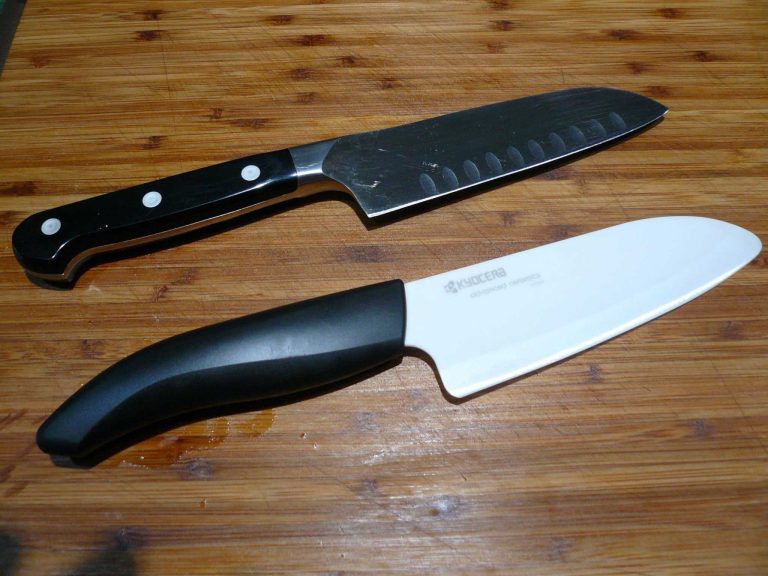Imagine slicing through a ripe tomato with ease, or effortlessly chopping vegetables without a hitch. When it comes to kitchen knives, choosing the right material can transform your cooking experience.
You might be wondering whether stainless steel or ceramic knives are the best choice for your culinary adventures. Both types have their unique advantages, and the decision can be quite intriguing. As you explore this article, you’ll uncover the secrets behind each type of knife, helping you make the perfect choice for your kitchen.
Whether you’re a seasoned chef or a home cook, understanding the differences between stainless steel and ceramic knives can elevate your cooking skills and streamline your food preparation. Keep reading to discover which knife material suits your needs best and how it can enhance your culinary journey.

Credit: bestchefkitchenknives.com
Material Composition
Understanding the material composition of knives is crucial. It affects performance and durability. Stainless steel and ceramic are popular choices. Each has unique attributes. Let’s explore their properties and characteristics.
Properties Of Stainless Steel
Stainless steel knives are durable. They resist corrosion effectively. This material contains chromium. It enhances rust resistance. Stainless steel is tough. It withstands impacts well. This makes it a reliable choice for kitchens. It can handle heavy-duty tasks. Stainless steel offers flexibility. It bends rather than breaks. This ensures longevity.
Characteristics Of Ceramic
Ceramic knives are lightweight. They feel comfortable in hand. This material is hard. It maintains sharpness longer than steel. Ceramic is non-reactive. It does not affect food taste. These knives are brittle, though. They can chip easily. Ceramic knives are stain-resistant. They remain clean with little effort. They are ideal for slicing fruits and vegetables. Their precision is unmatched.

Credit: www.youtube.com
Sharpness And Cutting Performance
Stainless steel knives offer reliable sharpness for versatile cutting tasks. Ceramic knives excel in sharpness but are fragile, requiring careful handling. Both materials provide distinct benefits, balancing durability and precision.
When choosing a knife, sharpness and cutting performance are often top priorities. The decision between stainless steel and ceramic knives can be puzzling. Both have their unique benefits, but how do they stack up against each other in terms of edge retention and precision cutting? Let’s dive into the details to help you make an informed choice.Edge Retention
Stainless steel knives are known for their durability. They maintain their edge longer than many other types of knives. Yet, they do require regular sharpening to keep their peak performance. Ceramic knives, on the other hand, are renowned for their exceptional edge retention. They can go months without needing a touch-up. However, if you accidentally drop them, the blade might chip, affecting its longevity. Imagine prepping for a big dinner and having to stop to sharpen your knife. With ceramic, this is less of a concern. But, are you willing to trade off the durability of steel for the low-maintenance of ceramic?Precision Cutting
Precision cutting is where ceramic knives shine. Their razor-sharp edges allow for thin, even slices. This makes them ideal for tasks like slicing tomatoes or filleting fish. Stainless steel knives offer precision too, but they might require a bit more effort. If you’ve ever tried to cut paper-thin slices for a salad, you know how crucial a sharp blade is. However, stainless steel provides more flexibility in cutting. They can handle tougher tasks like chopping bones or slicing hard vegetables. Are you more inclined to tackle precision tasks or do you need a versatile tool for various kitchen chores? Ultimately, the choice between stainless steel and ceramic knives depends on your cooking style and priorities. Whether you prioritize edge retention or precision, understanding these differences can help you select the perfect knife for your kitchen.Durability And Maintenance
Choosing between stainless steel and ceramic knives involves considering durability and maintenance. Both materials have unique properties. Understanding these can guide your decision.
Resistance To Wear
Stainless steel knives are known for their toughness. They resist rust and corrosion well. This makes them a long-lasting choice. Ceramic knives are incredibly hard. They maintain sharpness for a long time. Yet, they can chip if dropped or misused.
Ease Of Care
Stainless steel knives require regular sharpening. This keeps them efficient in cutting tasks. They are dishwasher safe. But hand washing is recommended to avoid dullness. Ceramic knives need less sharpening. Their edges stay sharp longer. Hand washing is best for these knives to prevent damage.
Safety And Handling
Stainless steel knives offer durability and resilience, ideal for robust use and versatile tasks. Ceramic knives, lighter and sharper, require careful handling to avoid chipping. Both types demand proper safety measures, ensuring precise cutting without accidents.
When choosing between stainless steel and ceramic knives, understanding safety and handling is crucial. Your kitchen experience can be significantly impacted by the ease of use and potential risks associated with each type. Whether you’re a seasoned chef or a home cook, the right knife can enhance your culinary journey.Handling Techniques
Proper handling of knives ensures safety and precision. Stainless steel knives require a firm grip and consistent pressure due to their weight and flexibility. You’ll notice they glide smoothly through dense materials. In contrast, ceramic knives are lightweight and require a gentle touch. Their sharpness demands minimal force, making them ideal for precision tasks like slicing vegetables thinly. Consider your comfort and control when choosing a knife. Experiment with both types to see which fits better in your hand and complements your cooking style.Risk Of Chipping And Breaking
Understanding the durability of your knife is essential for safety. Stainless steel knives are known for their resilience. They can withstand significant pressure without chipping, making them reliable for tough tasks. Ceramic knives, however, are prone to chipping if used on hard surfaces or bones. Their brittleness requires careful handling and storage. You might find this surprising if you’re used to steel knives’ robustness. Think about the types of foods you frequently prepare. If you often work with hard or frozen items, a stainless steel knife might be safer. On the other hand, if you prioritize precision over durability, a ceramic knife could be your go-to tool. As you consider these factors, ask yourself: What are my priorities in the kitchen? Is it durability, precision, or a balance of both? By reflecting on your needs, you’ll make a more informed choice that enhances your cooking experience.Cost And Value
Choosing the right knife for your kitchen involves considering various factors, and one of the most crucial is cost and value. Stainless steel and ceramic knives offer different benefits and drawbacks, impacting your wallet and long-term investment. Let’s dive into the details to help you make a decision that suits your budget and culinary needs.
Price Comparison
Stainless steel knives are generally more affordable than their ceramic counterparts. You can find a good quality stainless steel knife at a reasonable price, often sold in sets that offer great value for money. Ceramic knives, on the other hand, tend to be more expensive due to their manufacturing process and materials.
Think about your budget. Are you looking for a starter set or a single knife for specific tasks? Stainless steel might be your best bet for an economical choice. If you’re willing to invest more upfront, ceramic could be worth considering. Reflect on your culinary habits, and which type will serve you best for the money.
Long-term Investment
Stainless steel knives offer durability and flexibility, making them a reliable long-term investment. They can endure rigorous use and are easy to sharpen, ensuring a longer lifespan. However, they may require regular maintenance to prevent rust and dullness.
Ceramic knives boast incredible sharpness and retain their edge longer without needing sharpening. But, they are prone to chipping and breaking if mishandled. Consider how often you replace kitchen tools. Could a ceramic knife’s longevity and less frequent sharpening save you time and effort?
Think about your lifestyle. Do you prefer low-maintenance tools? A ceramic knife might be appealing. Are you diligent with upkeep? Stainless steel could be your ideal companion, offering value through resilience. Are you willing to pay more now for less hassle later?
Your knife choice reflects your cooking style and budget priorities. Whether you opt for stainless steel or ceramic, consider the cost and value each brings to your kitchen. Which knife do you think aligns best with your needs and culinary ambitions?

Credit: bestchefkitchenknives.com
Environmental Impact
Choosing between stainless steel and ceramic knives isn’t just about performance and durability; it’s also about considering their environmental impact. As you evaluate these options, it’s essential to think about how they affect our planet. Each material brings unique sustainability challenges and opportunities.
Sustainability Considerations
Stainless steel is known for its long-lasting nature. This means fewer replacements and less waste over time. If you’ve ever had a stainless steel knife in your kitchen, you know how it can withstand years of use.
Ceramic knives, while durable in their own right, can be brittle. They might chip or break, leading to more frequent replacements. Consider how often you are willing to buy a new knife and the resources required to produce them.
Think about the energy used in producing these materials. Stainless steel manufacturing involves energy-intensive processes. Ceramic production also consumes significant resources, though often less than steel.
Recycling And Disposal
Stainless steel is highly recyclable. If your knife reaches its end of life, recycling facilities can easily melt it down and repurpose the material. This is a huge win for reducing landfill waste.
Ceramic knives, however, pose a challenge in recycling. They are not as easily repurposed due to their composition. How will you dispose of a broken ceramic knife responsibly?
Consider the impact of throwing away these materials. Stainless steel’s recyclability gives it an edge in minimizing environmental harm. Ceramic knives require more thought and effort in disposal, potentially leading to more waste.
Your choices in the kitchen matter. How do your decisions today affect the environment tomorrow? Think about the entire lifecycle of your knives, from production to disposal, and make a choice that aligns with your values.
Ideal Uses And Applications
Stainless steel knives excel in durability and versatility, making them perfect for cutting tough foods. Ceramic knives, known for their sharpness and lightweight design, are ideal for slicing fruits and vegetables with precision. Both types offer unique benefits suited for different kitchen tasks.
Choosing between stainless steel and ceramic knives can be a tough decision. Each type has its own strengths and is suited for different tasks in the kitchen. Understanding the ideal uses and applications of these knives can help you make the best choice for your cooking style and needs.Best Uses For Stainless Steel
Stainless steel knives are the workhorses of the kitchen. They excel in everyday tasks like slicing, dicing, and chopping. Their durability makes them perfect for cutting through tougher foods like meat and dense vegetables. These knives are versatile and can handle a variety of kitchen tasks without needing frequent sharpening. If you’re someone who enjoys cooking a wide range of dishes, a stainless steel knife is a reliable choice. When you have to tackle a pumpkin or slice through a watermelon, stainless steel is your best friend. Its ability to withstand pressure without chipping is an added advantage.Optimal Applications For Ceramic
Ceramic knives are known for their precision and sharpness. They’re perfect for slicing fruits and vegetables with ease. Their lightweight nature makes them ideal for repetitive tasks that require a gentle touch. If you love preparing fresh salads or fruit platters, a ceramic knife will serve you well. Its sharp edge allows for paper-thin slices that enhance presentation and flavor. These knives don’t rust or impart a metallic taste, making them great for delicate foods like fish. However, they are not suitable for cutting through bones or frozen foods. Have you ever tried slicing tomatoes with a ceramic knife? The experience is a revelation, as the knife glides effortlessly, preserving the fruit’s integrity. Choosing the right knife for the task at hand can elevate your cooking experience. Which type of knife do you find indispensable in your kitchen?Frequently Asked Questions
Is Stainless Steel Or Ceramic Knives Better?
Stainless steel knives are durable and versatile, ideal for all-purpose use. Ceramic knives stay sharper longer and resist rust. Choose stainless steel for robustness and ceramic for precision. Both have their strengths, but your choice depends on specific needs and preferences.
What Are The Disadvantages Of Ceramic Knives?
Ceramic knives are brittle, prone to chipping, and challenging to sharpen. They can break easily if dropped. Not suitable for cutting hard foods or bones, ceramic knives may require professional sharpening. They can also be more expensive compared to stainless steel knives.
Do Chefs Use Ceramic Knives?
Chefs sometimes use ceramic knives for specific tasks. They stay sharp longer than steel knives but can be fragile. Ideal for slicing fruits and vegetables, they offer precision and ease. Not suitable for heavy-duty tasks, they complement steel knives in professional kitchens.
What Are The Disadvantages Of Stainless Steel Knives?
Stainless steel knives dull quickly, requiring frequent sharpening. They can be harder to maintain and repair if damaged. Some models lack the precision of high-carbon steel blades, affecting cutting accuracy. Stainless steel knives may also have poor edge retention compared to other materials, reducing their long-term effectiveness.
Conclusion
Choosing between stainless steel and ceramic knives depends on your needs. Stainless steel knives offer durability and easy sharpening. They’re ideal for everyday use. Ceramic knives stay sharp longer and resist rust. Perfect for precise cutting tasks. Consider your cooking habits.
Think about maintenance and longevity. Both options have unique benefits. Make an informed choice based on your kitchen tasks. Remember, the right knife enhances your cooking experience. Invest in quality tools for better results. Enjoy the ease and efficiency they bring to your meals.
Happy cooking!


